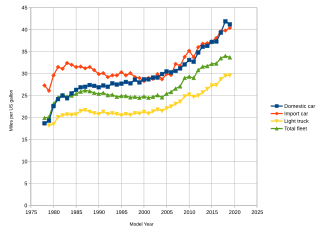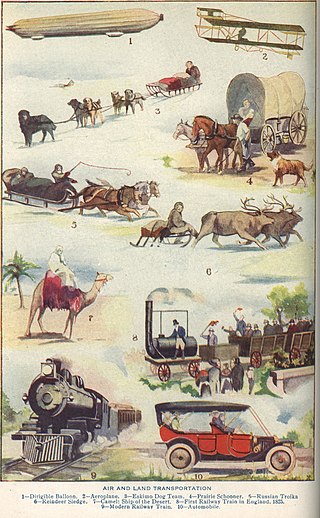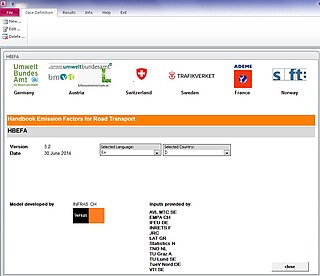The California Air Resources Board is an agency of the government of California that aims to reduce air pollution. Established in 1967 when then-governor Ronald Reagan signed the Mulford-Carrell Act, combining the Bureau of Air Sanitation and the Motor Vehicle Pollution Control Board, CARB is a department within the cabinet-level California Environmental Protection Agency.

Corporate average fuel economy (CAFE) standards are regulations in the United States, first enacted by the United States Congress in 1975, after the 1973–74 Arab Oil Embargo, to improve the average fuel economy of cars and light trucks produced for sale in the United States. More recently, efficiency standards were developed and implemented for heavy-duty pickup trucks and commercial medium-duty and heavy-duty vehicles.

Emission standards are the legal requirements governing air pollutants released into the atmosphere. Emission standards set quantitative limits on the permissible amount of specific air pollutants that may be released from specific sources over specific timeframes. They are generally designed to achieve air quality standards and to protect human life. Different regions and countries have different standards for vehicle emissions.
Road tax, known by various names around the world, is a tax which has to be paid on, or included with, a motorised vehicle to use it on a public road.
The New European Driving Cycle (NEDC) was a driving cycle, last updated in 1997, designed to assess the emission levels of car engines and fuel economy in passenger cars. It is also referred to as MVEG cycle.
The European Climate Change Programme (ECCP) was launched in June 2000 by the European Union's European Commission, with the purpose of avoiding dangerous climate change.

The European emission standards are vehicle emission standards for pollution from the use of new land surface vehicles sold in the European Union and European Economic Area member states and the United Kingdom, and ships in EU waters. The standards are defined in a series of European Union directives staging the progressive introduction of increasingly stringent standards.

The fuel economy of an automobile relates to the distance traveled by a vehicle and the amount of fuel consumed. Consumption can be expressed in terms of the volume of fuel to travel a distance, or the distance traveled per unit volume of fuel consumed. Since fuel consumption of vehicles is a significant factor in air pollution, and since the importation of motor fuel can be a large part of a nation's foreign trade, many countries impose requirements for fuel economy. Different methods are used to approximate the actual performance of the vehicle. The energy in fuel is required to overcome various losses encountered while propelling the vehicle, and in providing power to vehicle systems such as ignition or air conditioning. Various strategies can be employed to reduce losses at each of the conversions between the chemical energy in the fuel and the kinetic energy of the vehicle. Driver behavior can affect fuel economy; maneuvers such as sudden acceleration and heavy braking waste energy.
Various energy conservation measures are taken in the United Kingdom.
The ACEA agreement refers to a voluntary agreement between the European Automobile Manufacturers Association (ACEA) and the European Commission to limit the amount of carbon dioxide (CO2) emitted by passenger cars sold in Europe.

The energy efficiency in transport is the useful travelled distance, of passengers, goods or any type of load; divided by the total energy put into the transport propulsion means. The energy input might be rendered in several different types depending on the type of propulsion, and normally such energy is presented in liquid fuels, electrical energy or food energy. The energy efficiency is also occasionally known as energy intensity. The inverse of the energy efficiency in transport, is the energy consumption in transport.
United States vehicle emission standards are set through a combination of legislative mandates enacted by Congress through Clean Air Act (CAA) amendments from 1970 onwards, and executive regulations managed nationally by the Environmental Protection Agency (EPA), and more recently along with the National Highway Traffic Safety Administration (NHTSA). These standard cover common motor vehicle air pollution, including carbon monoxide, nitrogen oxides, and particulate emissions, and newer versions have incorporated fuel economy standards.
Bharat stage emission standards (BSES) are emission standards instituted by the Government of India to regulate the output of air pollutants from compression ignition engines and Spark-ignition engines equipment, including motor vehicles. The standards and the timeline for implementation are set by the Central Pollution Control Board under the Ministry of Environment, Forest and Climate Change.

The environmental effects of transport are significant because transport is a major user of energy, and burns most of the world's petroleum. This creates air pollution, including nitrous oxides and particulates, and is a significant contributor to global warming through emission of carbon dioxide. Within the transport sector, road transport is the largest contributor to global warming.
The, United States Environmental Protection Agency (EPA) began regulating greenhouse gases (GHGs) under the Clean Air Act from mobile and stationary sources of air pollution for the first time on January 2, 2011. Standards for mobile sources have been established pursuant to Section 202 of the CAA, and GHGs from stationary sources are currently controlled under the authority of Part C of Title I of the Act. The basis for regulations was upheld in the United States Court of Appeals for the District of Columbia in June 2012.
The Worldwide harmonized Light vehicles Test Procedure (WLTP) is a global standard for determining the levels of pollutants, CO2 emissions and fuel consumption of traditional and hybrid cars, as well as the range of fully electric vehicles.

Handbook Emission Factors for Road Transport (HBEFA) is a Microsoft Access database application providing emission factors, i.e. the specific emissions in g/km, for all current road vehicle categories. Emission factors are provided for all regulated and the most important non-regulated air pollutants as well as for fuel consumption and CO2. HBEFA is used to estimate road transport emissions on different spatial aggregation levels from national to street level.
A tolerance ring is a radially sprung ring that is press fitted between two mating components to act as a frictional fastener. They are flexible shims designed to fix two cylindrical parts together. The wavelike protrusions that run around the circumference of the ring generate a retention force to provide an optimal fit between the two mating components without the need for adhesive or excessive assembly force, simplifying the process for manufacturers. They allow for any misalignment caused by thermal expansion or excessive vibration. Tolerance rings can be used as bearing mounts and as a means of dealing with torque transfer, torque overload protection and axial slip between mating components. They are often used to isolate undesirable vibration in engines and electric motors, for noise-free mechanism operation in passenger vehicles and domestic appliances, where noise reduction has become a major trend in recent years. Modifications to tolerance rings can be made to tune the dynamic stiffness and, therefore, the frequencies that can be isolated.

The adoption of plug-in electric vehicles in Europe is actively supported by the European Union and several national, provincial, and local governments in Europe. A variety of policies have been established to provide direct financial support to consumers and manufacturers; non-monetary incentives; subsidies for the deployment of charging infrastructure; and long term regulations with specific targets. In particular, the EU regulation that set the mandatory targets for average fleet CO2 emissions for new cars has been effective in contributing to the successful uptake of plug-in cars in recent years
The Heavy Vehicle Emission Regulation 2019(EU) 2019/1242 is an EU regulation that limits the toxic exhausts of lorries, trucks or other heavy vehicles by auto-makers.







